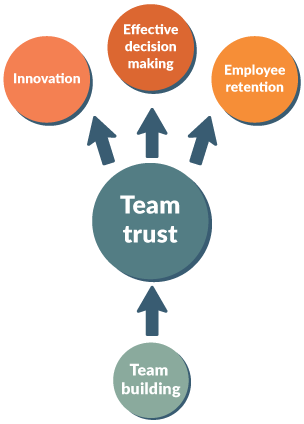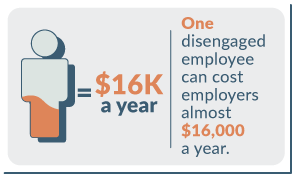Team building can be a time-consuming and somewhat stressful process for HR professionals, but all that time and effort is well worth the rewards. Why is team building important, and what is the real ROI of running events and activities outside of day-to-day work?
Team building is essential to so many critical functions of a team, including communication, collaboration, morale and productivity. Most importantly, team building contributes to establishing and maintaining team trust, which is directly tied to innovation, effective decision making and employee retention.

Team building refers to a broad term that covers all sorts of activities and events that bring teams together outside of their daily work tasks. A team-building activity could be as simple as an icebreaker before a meeting or an all-out, week-long retreat.
Why is team building so important?
Here are 13 reasons why you and your company can’t afford to go without it.
1. Improves communication
One of the top benefits of team building is improved employee communication. It helps each team member learn more about each other’s communication preferences and boundaries, as well as the importance of body language in communication.
Poor body language can derail otherwise effective communication. What people say with their body language can often contradict what they’re saying with their words. It’s incredibly easy to misunderstand someone if you’re not familiar with their communication style.
As an HR pro, you’ve probably dealt with your fair share of poor body language – crossed arms, slouching, avoiding eye contact, looking at a watch, etc. You can mitigate these poor behaviors and encourage both positive body language and effective verbal communication through team building.
An effective team-building program will ensure no employee feels intimidated or uncomfortable because they all know each other and how to communicate effectively. Keep in mind that communication is improved from any type of team-building exercise or event. What’s important is that you get your team to communicate with each other beyond day-to-day work tasks.
Team building example
With a show and tell ice breaker, ask team members to bring an item from their office or to grab one small item from the room at the beginning of a meeting. You don’t need to plan this in advance. Then, ask each team member to tell the group about the object in 20 to 60 seconds. Ask them to be as descriptive as possible. What it looks like? What’s its purpose? What do you like or dislike about it? This works great with remote teams, as they can quickly choose an item in their home office to share with the team over video.
2. Increases collaboration
As an HR professional, you know that when a team is strong and there’s trust among members collaboration is drastically enhanced. The stronger the team, the less likely it will descend into competition and chaos. Instead, everyone works together to achieve the same goal as opposed to trying to outshine each other.
When co-workers trust each other, they work together much more effectively. This leads to greater productivity and results the entire team can be proud of.
Team building example
Collaborate as a team to solve a problem without any limitations. What if anything were possible? Pick any sort of problem, such as “How can we keep our office kitchen clean?” or “How can we limit the time people spend commuting?” or “How can we improve our city’s air quality?” Next, work as a team to brainstorm ideas that have no limits. Cost is not a limitation, space is not a limitation and current science is not a ministration. Let the ideas go wild.
3. Provides learning opportunities and skill building
Technology and the ways in which we work are evolving rapidly and showing no signs of slowing down. To keep up with our ever-changing world, learning opportunities for employees need to be prioritized.
Team building example
Run a skill-building session based on your team’s interests by bringing the team together to learn as a group. Is anyone interested in learning more about graphic design? Coding? Or what about soft skills? Is anyone interested in becoming a better public speaker or building their leadership abilities?
When focusing on skill-building sessions, ensure you ask your team what they’re interested in. Involve the group and ensure everyone’s voice is heard.
4. Boosts morale and workplace happiness
Team building comes in all shapes and sizes. It doesn’t have to encompass a learning activity – it simply can be a fun activity everyone enjoys. This will light a spark of enthusiasm across your organization while allowing your team to take their mind off work, even for just a moment.
Enabling your team to let their hair down and blow off some steam every now and again does wonders for team morale. It reminds people of all they have in common, which creates a more positive and inclusive work environment.
Team building example
Cheers and beers or cheers and tears are great ways to cap off a finished project, whether it went the way the team expected or not. Take the team out for an after-work drink, ensuring there are plenty of options for those who don’t drink alcohol. If your team prefers daytime events, consider swapping out after-work drinks for a mid-day coffee, donut, milkshake or sundae.
5. Builds trust across teams
Trust is the most important quality in any relationship, so naturally, it’s no different at work. And as you already know, trust doesn’t just happen – it must be intentionally built from the ground up. You can’t trust someone without getting to know them, and a team can’t be unified without trust.
Your team could be made up of the most talented individuals in the world, and productivity will still grind to a halt without trust. If team members are suspicious of each other’s true motives and envious of each other’s successes, they won’t try to help each other; they’ll try to help themselves. Or worse, they’ll actively try to prevent each other’s success.
Team building builds trust and trust encourages collaboration. Many hands make light work, and a team that trusts each other stays together.
Team building example
Cookie navigation has team members use only the word “cookie” to guide blindfolded team members around a room full of obstacles. The only form of guidance that can be used is the word “cookie,” said in varying tones of voice. This exercise requires trust from the blindfolded team member and forces the other team members to really think about what precisely is being conveyed by their tone of voice.
6. Encourages creativity and innovation
Trust goes hand in hand with creativity and innovation. For team members to feel safe thinking outside of the box, they must trust each other.
They need to know that their wild, out-there idea won’t be shot down or made fun of. They need to feel safe to fail and to learn from those mistakes to find true innovation as a team. Plus, when the people around you have your back, you’re more willing to express concerns, provide constructive feedback and build off one another to create something new and wonderful.
Consider team-building opportunities that allow team members to get messy. Show them that it’s okay to fail occasionally because they have team members who are there to pick them up; plus, everyone can learn from and innovate from small failures.
Team building example
Any arts and crafts activity will promote creativity and innovation. Consider an activity that’s designed to be a bit messy or imperfect, like finger painting or making silly hats.
7. Reinforces commitment and loyalty

Employee disengagement is a serious problem. In 2022, 17% of employees were actively disengaged, according to Gallup. Keep in mind just a single disengaged employee at an average salary level can cost employers almost $16,000 a year.
Today more than ever, a job is much more than a paycheck. Employees want to feel comfortable in their roles and with the people they work with.
When teams engage in meaningful, fun activities that involve achieving a common goal, it brings them closer together. They start to see each other as more than just co-workers – they start to see each other as friends. If you have friends you get to see at work every day, it makes you much less likely to look for work elsewhere. This reinforces an employee’s commitment to your organization.

Team building example
Skip level meetings are an opportunity for team members to skip over their own boss to meet with their boss’s boss. While this may sound scary at first, this meeting is not a test. It’s a chance for lower-ranking team members to get to know people on the team they wouldn’t regularly meet with. Both people in the skip level meeting can share their ideas for the future of the company, discuss the ups and downs of their role, and speak about hobbies and interests outside of work. Prioritizing opportunities like this illustrates to the whole team that everyone, no matter their role or rank, is important and has a voice in the company.
8. Improves decision making
Improved decision making is another key benefit that falls back on trust. As employees spend more time together through intentional team building, they learn to trust each other, which is directly tied to decision making.
When team members trust each other, they can make faster, more effective decisions because they know they can count on each other. This is an incredible benefit to the entire company because faster, better decisions equal improved productivity.
There’s less going back and forth because each employee can count on their team member to make the right call.
Team building example
Pancakes vs. waffles is a simple icebreaker that helps teams come to a consensus. Begin with pancakes vs. waffles. Which is better? If only one could be kept in our universe and the other obliterated forever, which would the team choose? If necessary, take a vote to decide. Once a decision has been made, add something else into the mix with the chosen item, such as waffles vs. bacon. Continue getting more creative with your combinations, such as adding in puppies, hot showers or pillows.
9. Prevent misunderstandings
Team building prevents misunderstandings and conflict because each team member is comfortable and used to communicating with each other. They aren’t afraid to seek clarification or ask questions in the face of a potential misunderstanding – they want to work things out and continue building their company relationships.
Everyone has a different way of communicating, which can lead to people not understanding where another person on the team is coming from. For example, Fred might think: Why is Ellen so quiet around me? Did I do something wrong? While Ellen might be thinking: Why is Fred always so loud when he asks me a question? Did I do something wrong?
The reality is that most of our misunderstandings come from just that: a misunderstanding. People want to get along. They want to understand each other, and they want to feel understood.
Through team building, you can help team members better understand their preferred communication styles and the communication styles of the teammates they work with on a regular basis.
Team building example
Consider running a workplace team building session on Enneagrams, DiSC or another communication assessment to help employees get to know, understand and embrace each other’s differences.
10. Acknowledge wins
Celebrate your wins together! When your team accomplishes a milestone, they must hear about it. It’s vital to the strength of the team that each coworker shares in each other’s accomplishments. This reinforces the fact that a win for one team member equals a win for the whole team. So, take a break to celebrate your team and allow them to celebrate each other.
Team building example
Plan a celebration to give your co-workers the opportunity to relax and get to know each other outside of a strict workplace setting. These types of team-building events illustrate how important the individuals on a team are to a company’s success.
Learn more from the ultimate guide to employee recognition.
11. Cultivate leadership
Team building activities don’t have to be run by HR pros – allow the team to take ownership of the events and activities they want to experience.
Pass over the reins to let interested team members lead initiatives. Team-building activities are an ideal platform for cultivating leadership qualities. This not only helps the individual grow personally and professionally but also benefits the organization in the long run, as you’ll have more thoughtful leaders on your team who are ready and willing to help grow the business – with leadership skills to back up their drive.
Team building example
Escape rooms bring teams together to solve a common goal, and they also promote leadership skills. Since there’s a set time the team must complete the challenge, defining a leader can help the team make decisions more efficiently. Have the team alternate in the role of leader to encourage multiple voices to hone their leadership skills.
12. Retain current talent
Be intentional about team building, as while you may imagine (or hope) everyone is getting along and enjoying their job, the numbers may alarm you. Over 4 million people quit their jobs each month in the US in 2022. With so many varied employment opportunities out there and the steady rise of remote work, it’s becoming easier for employees to bounce from one job to the other.
And then you have quiet quitting to worry about. An employee may not actually quit or leave your company physically, but if they’ve decided to check out and are disengaged, the problem still exists. They may act like they’ve quit, spreading their lack of motivation, lowered productivity and general bad vibes across the organization.
A team member is far more likely to stay right where they are and continue to give it their all if they trust and value the people they work with. They may even overlook aspects of the job that they don’t like because they care so much for their team and couldn’t imagine working anywhere else.
Team building example
While variety in team-building activities is important, consistency is also beneficial. A recurring team lunch, either once a week or once a month, can be an event employees will expect and look forward to. Recurring events allow team members to form relationships and build rapport with one another.
For more information on keeping your employees engaged, read 5 wellness trends to improve employee engagement & retention.
13. Attract new talent
Building a strong, happy team is an advertisement in and of itself. Why do talented employees seek your organization and look for any opportunity to be hired by you? They’ve heard directly from your own team about how great it is to work at your company.
Think of all the time (and money) you’ll save when trained, capable talent comes straight to your door because they’ve heard great things about your company from those who already work there.
Team building example
Take your team out somewhere special for an event everyone will keep talking about. Get creative here. You might go to an alpaca farm, hire a tarot card reader for the office, go rock climbing or learn to juggle. What unique experience can your team bond over?
For best results, consult your team on the type of activities they’re interested in and ensure everyone is comfortable, able to participate and not allergic before setting anything in stone.
Putting team building into practice
Now that you understand the importance of team building and the immense impact it can have on both your team and the company at large, it’s time to put it into practice.
Make team building a priority because you can’t afford not to. Teams that don’t spend time together are unable to build trust, which can spiral all sorts of critical team aspects out of control, including collaboration, motivation, and productivity.
Need some ideas to get you started? Check out 12 team-building activities your employees will love.


